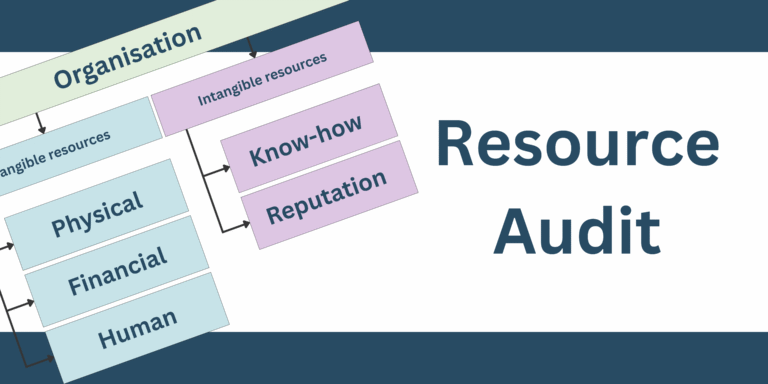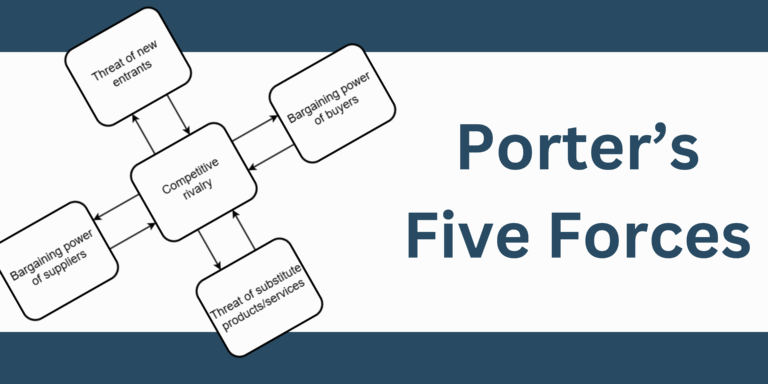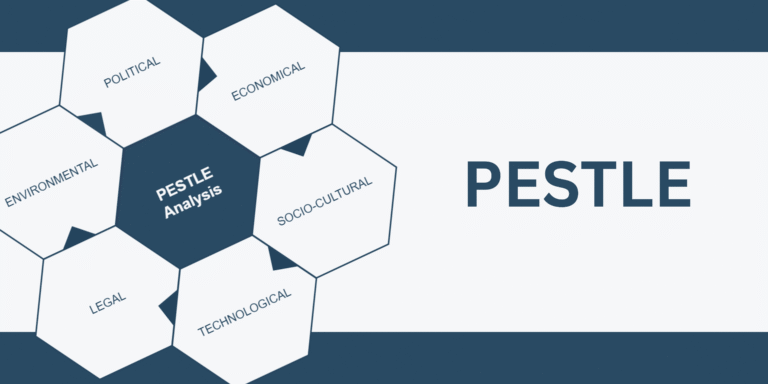VMOST Analysis: Definition, Examples & AI Prompts
If you’re a business analyst, strategist, or just someone trying to figure out whether your team is actually moving in the right direction, VMOST analysis is a great tool to start with. This method helps you align your long-term vision with the daily grind – so you’re not just busy, you’re actually being productive.
In this guide, we’ll break down exactly what VMOST analysis is, show you how to conduct a VMOST analysis, and give you real-life examples (yes, including Starbucks and Coca-Cola).
What is VMOST analysis?
VMOST analysis is a strategic planning framework used to align an organization’s high-level vision and mission with measurable objectives, clear strategies, and actionable tactics.
VMOST stands for:
- Vision – Where are we going long-term?
- Mission – Why do we exist? What’s our purpose?
- Objectives – What specific goals do we need to hit?
- Strategy – What’s the game plan to reach those goals?
- Tactics – What are the exact actions or steps we’ll take?
So, VMOST analysis is a structured way to make sure your big dreams match your everyday efforts. It’s like zooming out and in at the same time, looking at the 10,000-foot view and the to-do list side-by-side.
It’s popular among business analysts, product managers, and strategy consultants because it avoids fluffy vision statements that no one uses. Instead, it breaks everything down into a practical, workable plan.
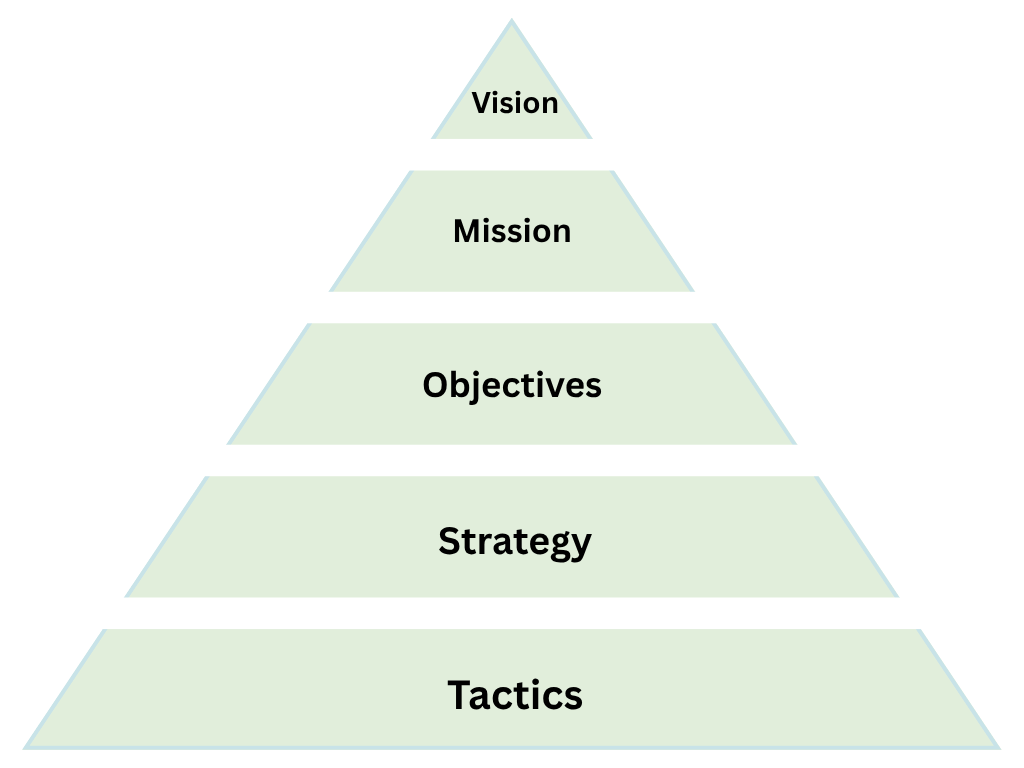
Advantages and disadvantages of VMOST
Like any tool, VMOST has its strengths and limitations.
Advantages:
- Clear alignment. It ties together all levels of planning – from purpose to actions.
- Simplicity. Easy to understand and apply, especially in workshops.
- Great for team alignment. Everyone knows what they’re working toward and how.
- Flexible. Works for companies, teams, or even personal goal setting.
Disadvantages:
- Can feel high-level. Tactics may still need project plans or OKRs for full execution.
- Assumes clear vision and mission. If leadership is fuzzy, the rest will be too.
- Not a diagnostic tool. It won’t fix broken systems, but it helps plan for success.
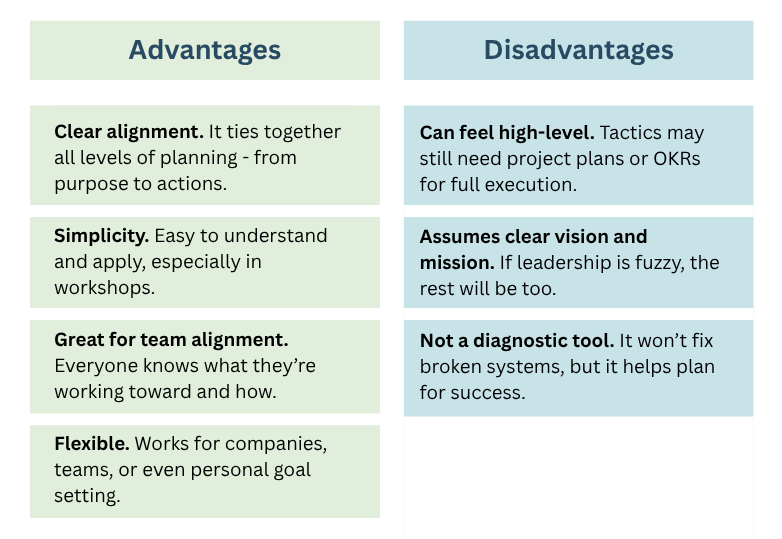
When to conduct a VMOST analysis
A VMOST analysis is useful when:
- You’re launching a new project or product and need clarity.
- A team or company is losing direction or struggling with alignment.
- You’re building a strategic roadmap and want to tie everything together.
- You’re doing a strategy refresh and want to check that goals still align with vision.
It’s also perfect during annual planning, post-merger alignment, or even career planning (yes, you can do a personal VMOST).
How to conduct a VMOST analysis
Conducting a VMOST analysis is usually a pretty straightforward process. Here’s a simple step-by-step guide:
1. Define the Vision
Start with the big picture. Where do you want to be in 3, 5, or 10 years? Make it aspirational but grounded.
Example: “To become the leading provider of ethical, sustainable coffee globally.”
2. Clarify the Mission
What’s your purpose? Why do you exist? This should explain how you bring value.
Example: “To source and serve high-quality coffee while uplifting the communities that grow it.”
3. Set clear Objectives
Now translate that into SMART goals—specific, measurable, achievable, relevant, time-bound.
Example: “Open 100 new stores in Southeast Asia by 2027.”
4. Design the Strategy
These are the big moves to reach your objectives. Think of them as themes or strategic pillars.
Example: “Partner with local fair-trade suppliers and invest in digital customer loyalty programs.”
5. List the Tactics
Time to get specific. What exactly will people be doing?
Example: “Hire regional supplier relationship managers. Launch app-based rewards by Q3.”
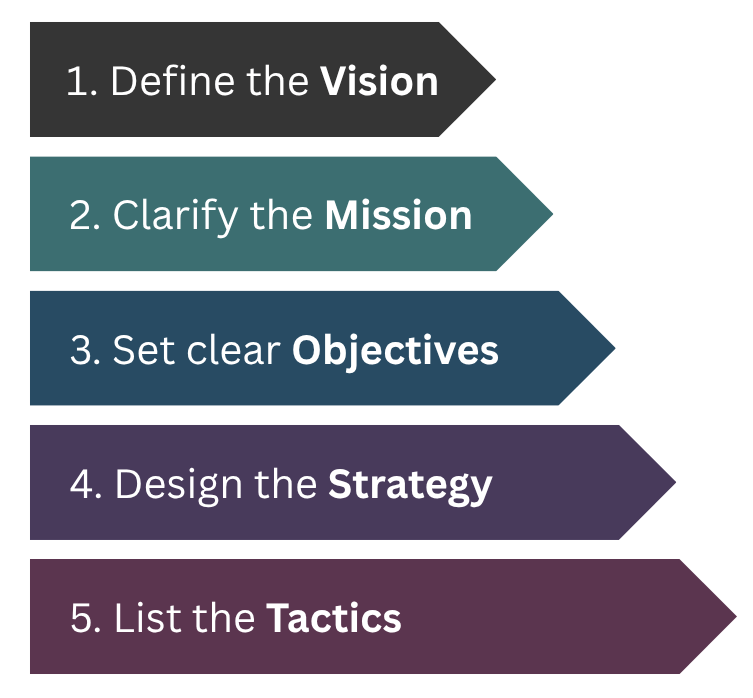
Example of VMOST analysis
Let’s walk through a few examples so you can see it in action:
VMOST Analysis of Coca-Cola
| VMOST Element | Example |
| Vision | To refresh the world and make a difference. |
| Mission | To craft the brands and drinks people love, to refresh them in body and spirit. |
| Objectives | Increase global market share in the sparkling beverage category by 5% over the next 3 years. |
| Strategy | Expand distribution in emerging markets; invest in sustainable packaging; diversify product lines. |
| Tactics | Launch marketing campaigns in Asia; partner with recycling orgs; roll out zero-sugar variants. |
VMOST Analysis of Starbucks
| VMOST Element | Example |
| Vision | To inspire and nurture the human spirit—one person, one cup, and one neighborhood at a time. |
| Mission | To establish Starbucks as the premier purveyor of the finest coffee while maintaining ethical sourcing. |
| Objectives | Improve customer retention by 15% by 2026. |
| Strategy | Elevate in-store experience; expand mobile ordering; build local community engagement. |
| Tactics | Redesign store interiors; offer personalized app offers; sponsor local events. |
VMOST Analysis of Technology in Education
| VMOST Element | Example |
| Vision | To transform education through inclusive and accessible digital technology. |
| Mission | To provide scalable tech tools that support personalized learning and student engagement. |
| Objectives | Equip 10,000 classrooms with AI-powered learning platforms by 2026. |
| Strategy | Partner with edtech firms; lobby for policy support; develop teacher training programs. |
| Tactics | Host workshops; build open-source tools; run pilot projects in underserved schools. |
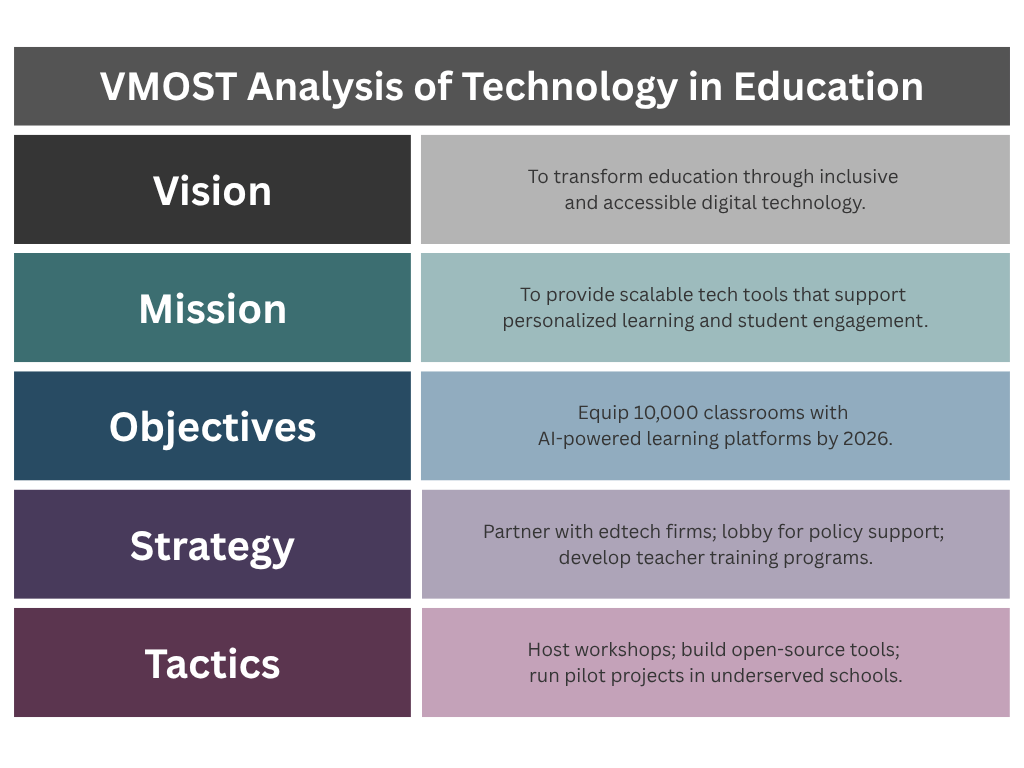
AI prompts to create a VMOST analysis
You can use tools like ChatGPT to help generate your VMOST analysis. Here are a few helpful prompts:
- “Generate a VMOST analysis for a startup that builds AI-powered productivity apps.”
- “Based on this mission statement, suggest vision, objectives, strategy, and tactics: [Insert Mission].”
- “Turn this business idea into a full VMOST framework: [Insert idea]”
- “Help me align my company’s quarterly goals with our long-term vision using VMOST.”
These prompts work great in strategic planning workshops or when you’re staring at a blank whiteboard wondering where to start.
Related business analysis techniques
VMOST fits nicely with other popular business analysis frameworks:
- SWOT Analysis – Use SWOT to identify strengths, weaknesses, opportunities, and threats before defining your VMOST.
- PESTLE Analysis – Scan the external environment to inform your strategy layer.
- Resource Audit – Understand what internal capabilities support your mission and strategy.
- Porter’s Five Forces – Use this to evaluate market competitiveness before setting goals.
Think of VMOST as the high-level planner, and these tools as the researchers feeding it with intel.
Final thoughts
If you’ve ever had a strategy that sounded great in theory but went nowhere in execution, VMOST is your fix. It forces alignment, breaks down silos, and helps teams pull in the same direction. Whether you’re analyzing a global brand like Coca-Cola or rethinking how technology can change education, VMOST analysis turns vague aspirations into clear, actionable plans.


